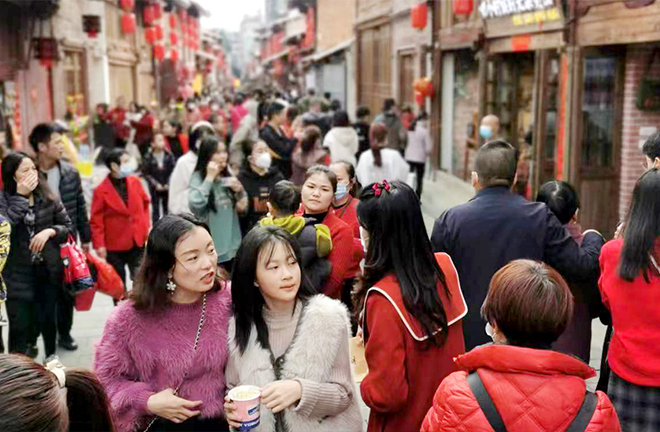Hot holiday consumption vibe mirrors China’s economic vitality

Visitors enjoy shopping at a cultural street in Putian, Fujian Province, on Jan. 23 during the Chinese New Year. Photo: Chen Mirong/CSST
Given the consumption boom during the Chinese New Year of 2023, scholars believe the good start reflects the huge potential and resilience of China’s consumer market. The boom also showcases the continuous emergence of new-type service consumption, as well as the continuous expansion and innovation of new consumption scenarios and new business formats in the country.
Market vitality
Statistics show that during this Chinese New Year, the sales revenue of consumption-related industries in China saw a year-on-year increase of 12.2%. Among them, the growth of service consumption such as food, tourism, and movies was particularly noteworthy. The year-on-year growth rate of domestic tourism revenue reached as high as 30%, while service consumption increased by 13.5% year-on-year.
Sheng Bin, dean of the School of Economics at Nankai University, said that the hot consumer market during the Chinese New Year was partly due to seasonal factors. The combination of the festival and the holiday stimulated consumption in transportation, hotels, and tourism. Moreover, optimized epidemic prevention and control policies unleashed much consumer demand.
As the market demand was released, local consumption policies contributed significant impact. Chen Yanbin, a professor of economics at Renmin University of China, noted that during the Chinese New Year, local governments prioritized the recovery and expansion of consumption in accordance with requirements of the Central Economic Work Conference in 2022. By issuing consumer vouchers and innovating with consumption scenarios, residents’ consumption demand was further stimulated, Chen added.
From the perspective of China’s economic fundamentals, despite the epidemic’s certain negative impact, the economy has maintained growth momentum. In 2022, China’s GDP registered 121 trillion yuan. The per capita GDP increased by 3% over the previous year to 85,698 yuan ($12,741), and has remained above $12,000 for two consecutive years. Economic growth, abundance of products, and price stability laid fundamentally solid groundwork for the consumption boom during the Chinese New Year.
Li Yongjian, a research fellow from the National Academy of Economic Strategy at the Chinese Academy of Social Sciences, said that the consumption boom around the holiday was inseparable from China’s efforts to keep optimizing the overall supply-side structure. Many innovations on the supply side, such as continuously upgrading household appliances and daily necessities, have further inspired consumption potential and met Chinese residents’ needs for consumption structure upgrade as well as their demand for increasingly high-quality and diversified goods and services.
According to statistics, during the Chinese New Year, the number of home appliance trade-in orders in stores across the country quadrupled year-on-year. The sales of new household appliances like robot vacuums, floor scrubbers, and dishwashers rose by 120% year-on-year, reflecting a general trend of consumption structure upgrading and optimization.
Expanding domestic demand
Since the 18th CPC National Congress in 2012, China has firmly implemented the strategy of expanding domestic demand and facilitating a strong domestic market. The supporting role of domestic demand in economic development has been significantly enhanced.
In 2022, a guideline on expanding domestic demand (2022–2035) and an implementation plan for expanding domestic demand during the 14th Five-Year Plan period (2021–2025) were successively issued.
The Central Economic Work Conference in 2022 proposed focusing on boosting domestic demand by prioritizing the recovery and expansion of consumption, enhancing consumption capacity, improving consumption conditions, and innovating with consumption scenarios. This has provided important guidance for the country to focus on expanding domestic demand and enhancing the fundamental role of consumption in economic development.
Chen believes that to fully leverage the role of consumption in driving economic growth, it is essential to foster a new growth model in which consumption and investment promote each other and form a virtuous cycle.
Since the reform and opening up, China has achieved high-speed growth through the “high savings-high investment” model, which also brought about the problem of low consumption rates. As such, in the stage of high-quality development, it is necessary to optimize and adjust the previous growth model and build a virtuous circle of investment and consumption in order to spur consumption, Chen said.
In addition, Chen stressed the need to strengthen the effective coordination of macro policies, integrating policies of promoting stability, fueling growth, and optimizing economic structure. It is also crucial to unblock the transmission channels of monetary and fiscal policies and improve the overall efficiency of macro control so as to better expand consumption.
Edited by CHEN MIRONG
